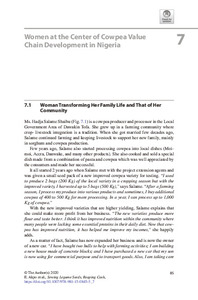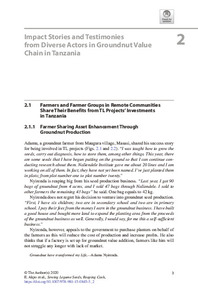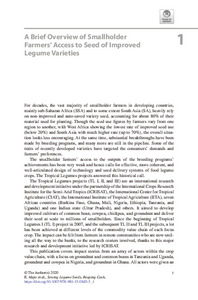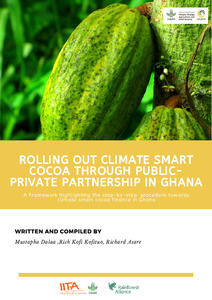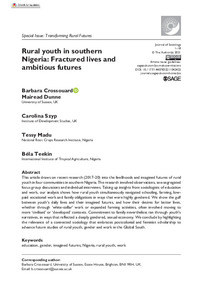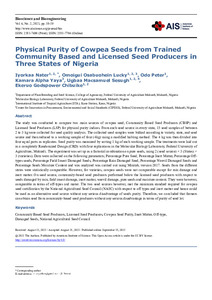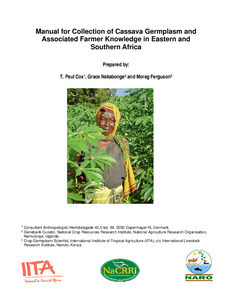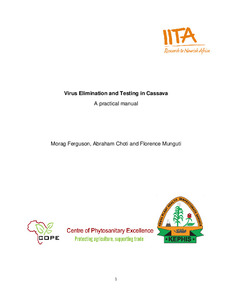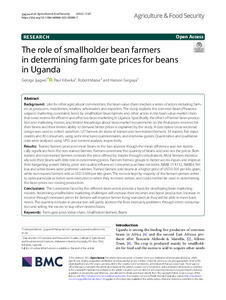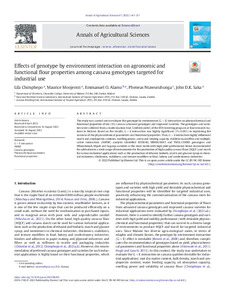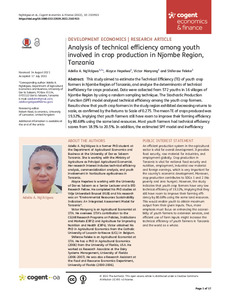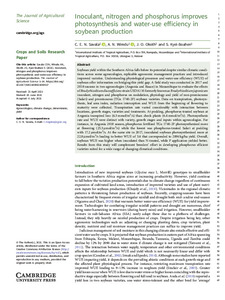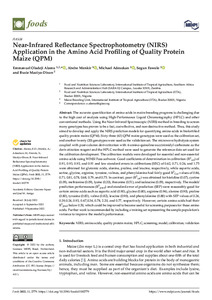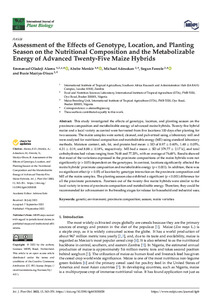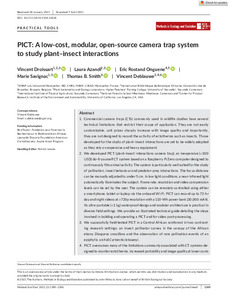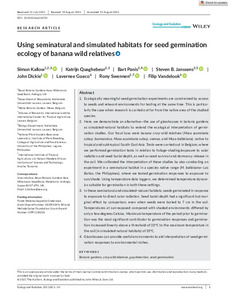Welcome to the International Institute of Tropical Agriculture Research Repository
IITA Bibliography System: Recent submissions
Now showing items 841-860 of 8099
-
Women at the center of cowpea value chain development in Nigeria
(Springer International Publishing, 2020)M s. Hadja Salame Shaibu (Fig. 7.1) is a cowpea producer and processor in the Local Government Area of Dawakin Tofa. She grew up in a farming community where crop- livestock integration is a tradition. When she got married few decades ago, Salame continued farming and keeping livestock to support her new family, mainly in sorghum and cowpea production. -
Impact stories and testimonies from diverse actors in groundnut value chain in Tanzania
(Springer International Publishing, 2020)Adamu, a groundnut farmer from Maugura village, Masasi, shared his success story for being involved in TL projects . “I was taught how to grow the seeds, carry out diagnosis, how to store them, among other things. This year, there are some seeds that I have begun putting on the ground so that I can continue conducting research about them. Naliendele Institute gave me about 20 lines and I am working on all of them. In fact, they have not yet been named. I’ve just planted them in plots; from plot ... -
A brief overview of smallholder farmers' access to seed of improved legume varieties
(Springer International Publishing, 2020)For decades, the vast majority of smallholder farmers in developing countries, mainly sub-Saharan Africa (SSA) and to some extent South Asia (SA), heavily rely on non-improved and auto-saved variety seed, accounting for about 80% of their material used for planting. Though the seed use figures by farmers vary from one region to another, with West Africa showing the lowest rate of improved seed use (below 20%) and South Asia with much higher rate (up to 70%), the overall situation looks less ... -
Breakthroughs in groundnut production communities in Nigeria
(Springer International Publishing, 2020)Mrs. Hadja Talatu Idrissa (Fig. 6.1), a community women leader, is the chairperson of the Bunkure women group that is active in groundnut production and oil processing. The group which counts 25 members joined the TLIII project family 4 years ago. They started growing a small seed pack of 5 kg in their community farmland. “It was the harvest of this seed pack that we revolved and planted in a bigger farm plot in the following year,” reported Mrs. Hadja. -
Rolling out climate smart cocoa through public-private partnership in Ghana: a framework highlighting the step-by-step procedure towards climate smart cocoa finance in Ghana
(International Institute of Tropical Agriculture, 2020)The cocoa industry has been the mainstay of the Ghanaian economy over the years through the provision of revenues from foreign exchange earnings and the generation of employment for farmers who are mainly small holders. Climate change is a phenomenon that has been taking place throughout history but over the last century it has accelerated and scientists believe it is increasingly due to human activities (Cook et al, 2016). The climate in Ghana has likewise been affected and it is having an impact ... -
Rural youth in southern Nigeria: fractured lives and ambitious futures
(2021)This article draws on recent research (2017–20) into the livelihoods and imagined futures of rural youth in four communities in southern Nigeria. The research involved observations, sex-segregated focus group discussions and individual interviews. Taking up insights from sociologists of education and work, our analysis shows how rural youth simultaneously navigated schooling, farming, low-paid vocational work and family obligations in ways that were highly gendered. We show the gulf between youth’s ... -
Physical purity of cowpea seeds from trained community based and licensed seed producers in three states of Nigeria
(2021)The study was conducted to compare two main sources of cowpea seed, Community Based Seed Producers (CBSP) and Licensed Seed Producers (LSP) for physical purity indices. From each seed source in every state, 15 seed samples of between 2 to 3 kg were collected for seed quality analysis. The collected seed samples were bulked according to variety, state, and seed source and then reduced to a working sample of four (4kg) using a modified halving method. The 4 kg was then divided into four equal parts ... -
Manual for collection of cassava germplasm and associated farmer knowledge in eastern and southern Africa
(International Institute of Tropical Agriculture, 2014) -
Virus elimination and testing in cassava: a practical manual
(International Institute of Tropical Agriculture, 2020) -
The role of smallholder bean farmers in determining farm gate prices for beans in Uganda
(2022-09-07)Like for other agricultural commodities, the bean value chain involves a series of actors including; farmers as producers, middlemen, retailers, wholesalers and exporters. The study explains the common bean (Phaseolus vulgaris) marketing constraints faced by smallholder bean farmers and other actors in the bean value market chain that need redress for efficient and effective bean marketing in Uganda. Specifically, the effect of farmer bean production and marketing modes, and limited knowledge about ... -
Effects of genotype by environment interaction on agronomic and functional flour properties among cassava genotypes targeted for industrial use
(2022-12)The study was carried out to evaluate the genotype by environment (G × E) interaction on physicochemical and functional properties of ten (10) cassava advanced genotypes and improved varieties. The genotypes and varieties were collected from a multi-location trial (Uniform yield) of the IITA breeding program at four research stations in Malawi. Based on the results, G × E interaction was highly significant (P ≤ 0.001) in explaining the variance of the physicochemical parameters and functional ... -
Analysis of technical efficiency among youth involved in crop production in Njombe Region, Tanzania
(2022-09-02)This study aimed to estimate the Technical Efficiency (TE) of youth crop farmers in Njombe Region of Tanzania, and analyze the determinants of technical inefficiency for crops produced. Data were collected from 572 youths in 16 villages of Njombe Region by using a random sampling technique. The Stochastic Production Function (SPF) model analysed technical efficiency among the youth crop farmers. Results show that youth crop farmers in the study region exhibited decreasing returns to scale, as ... -
Inoculant, nitrogen and phosphorus improves photosynthesis and water-use efficiency in soybean production
(2021)Soybean yield within the Southern Africa falls below its potential despite similar climatic conditions across some agroecologies, replicable agronomic management practices and introduced improved varieties. Understanding physiological processes and water-use efficiency (WUE) of soybean offer information on bridging this yield gap. A field study was conducted in 2017 and 2018 seasons in two agroecologies (Angonia and Ruace) in Mozambique to evaluate the effects of Bradyrhizobium diazoefficiens ... -
The future of farming: Who will produce our food?
(2021)Achieving SDG2 (zero hunger) in a situation of rapid global population growth requires a continued focus on food production. Farming not merely needs to sustainably produce nutritious diets, but should also provide livelihoods for farmers, while retaining natural ecosystems and services. Rather than focusing on production principles, this article explores the interrelations between farms and farming systems in the global food system. Evaluating farming systems around the world, we reveal a bewildering ... -
Near-Infrared Reflectance Spectrophotometry (NIRS) application in the amino acid profiling of Quality Protein Maize (QPM)
(2022-09-09)The accurate quantification of amino acids in maize breeding programs is challenging due to the high cost of analysis using High-Performance Liquid Chromatography (HPLC) and other conventional methods. Using the Near-Infrared Spectroscopic (NIRS) method in breeding to screen many genotypes has proven to be a fast, cost-effective, and non-destructive method. Thus, this study aimed to develop and apply the NIRS prediction models for quantifying amino acids in biofortified quality protein maize (QPM). ... -
Assessment of the effects of genotype, location, and planting season on the nutritional composition and the metabolizable energy of advanced twenty-five maize hybrids
(2022-09-09)This study investigated the effects of genotype, location, and planting season on the proximate composition and metabolizable energy of advanced maize hybrids. Twenty-five hybrid maize and a local variety as control were harvested from five locations 100 days after planting for two seasons. The maize samples were sorted, cleaned, and pulverized using a laboratory mill and were analyzed for nutritional composition and metabolizable energy (ME) using standard laboratory methods. Moisture content, ... -
PICT: A low-cost, modular, open-source camera trap system to study plant–insect interactions
(2021)Commercial camera traps (CTs) commonly used in wildlife studies have several technical limitations that restrict their scope of application. They are not easily customizable, unit prices sharply increase with image quality and importantly, they are not designed to record the activity of ectotherms such as insects. Those developed for the study of plant–insect interactions are yet to be widely adopted as they rely on expensive and heavy equipment. We developed PICT (plant–insect interactions camera ... -
Genetic analysis of grain yield and resistance of extra-early-maturing maize inbreds to northern corn leaf blight
(2021)Maize (Zea mays L.) is a food security crop in sub-Saharan Africa (SSA). Incidence of northern corn leaf blight (NCLB), caused by Exserohilum turcicum, in lowlands of SSA during the past decade has caused 30–70% reduction in maize yield. This study (a) examined the combining abilities of extra-early maize (EEM) inbreds and classified them into heterotic groups; (b) elucidated gene action controlling resistance to NCLB; (c) assessed grain yield (GYLD) and yield stability of EEM hybrids underNCLB ... -
Using seminatural and simulated habitats for seed germination ecology of banana wild relatives
(2021-10-11)Ecologically meaningful seed germination experiments are constrained by access to seeds and relevant environments for testing at the same time. This is particularly the case when research is carried out far from the native area of the studied species. Here, we demonstrate an alternative—the use of glasshouses in botanic gardens as simulated-natural habitats to extend the ecological interpretation of germination studies. Our focal taxa were banana crop wild relatives (Musa acuminata subsp. burmannica, ... -
Trait profile of maize varieties preferred by farmers and value chain actors in northern Ghana
(2021-07-06)Plant breeders’ knowledge of precise traits preferred by variety users would accelerate varietal turnover and widen adoption of newly developed maize varieties in Ghana. The objective of this research was to provide empirical evidence of trait preferences of farmers and other actors in the maize value chain in northern Ghana, based on which research strategies for maize improvement could be formulated. Participatory rural appraisal was conducted in 2016 to determine key traits preferred by maize ...

